Roll crushers consist of two or more adjacent rolls placed parallel to each other and rotated in opposite directions. Single roll crushers are also available which rotate a single roll against a fixed breaker plate. Mineral or rock particles placed between the rolls are nipped and then crushed as they pass between the rolls. Rolls are held against each other by springs.
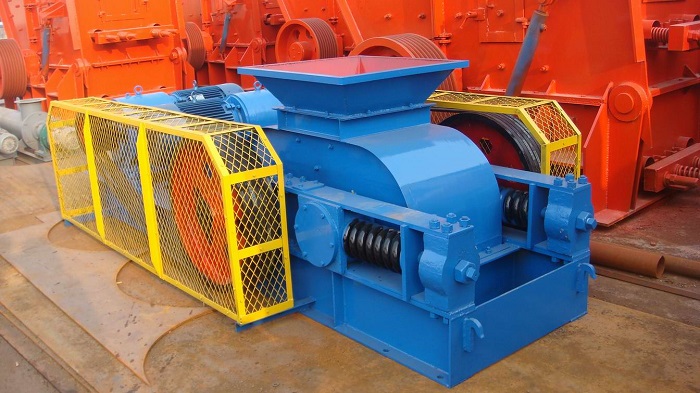
Roll crusher structure
Two types of roll crushers are generally designed. In the first type both rolls are rigidly fixed to a frame with provision for adjusting the lateral position of one of the rolls to control the gap between them. Once set these rolls are locked into place. One roll is attached to the driving mechanism while the other rotates by friction. Single roll crushers are also available which rotate a single roll against a fixed breaker plate. In the second type, at least one roll is spring mounted which forms the driving roll, the other roll rotates by friction (Fig.1).
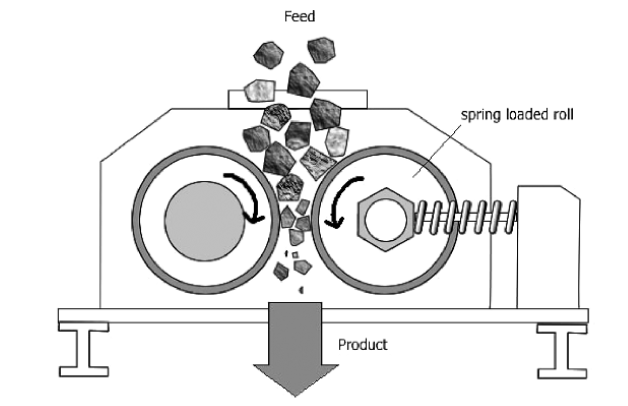
Fig1. Schematic Diagram of Roll Crusher
Some rollers are toothed. The shape of the teeth is generally pyramidal. The roll surfaces
play an important part in the process of nipping a particle and then dragging it between the
rolls. The corrugated and ribbed surfaces offer better friction and nip than smooth surfaced rolls. The toothed surfaces offer additional complex penetrating and compressive forces that help to shatter and disintegrate hard rock pieces.
The distance between the rolls is adjusted by nuts at the end of one of the rolls. The nip
angle is affected by the distance between the rolls. The nip angle is defined as the angle that is tangent to the roll surface at the points of contact between the rolls and the particle. It dependson the surface characteristics of the rolls. Usually the nip angle is between 20° and 30° but in some large roll crushers it is up to 40°.
Roll crusher circuit
Roll crushers are generally not used as primary crushers for hard ores. Even for softer ores, like chalcocite and chalcopyrite they have been used as secondary crushers. Choke feeding is not advisable as it tends to produce particles of irregular size. Both open and closed circuit crushing are employed. For close circuit the product is screened with a mesh size much less than the set.
Fig. 2 is a typical set up where ore crushed in primary and secondary crushers are further
reduced in size by a rough roll crusher in open circuit followed by finer size reduction in a
closed circuit by roll crusher. Such circuits are chosen as the feed size to standard roll
crushers normally do not exceed 50 mm.
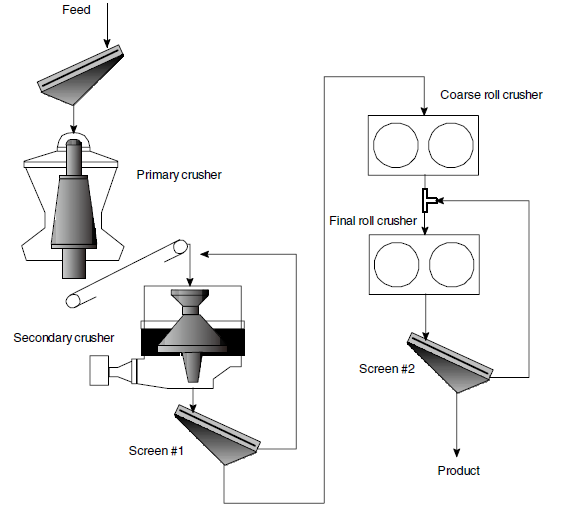
Fig2. roll crusher circuit
High Pressure Grinding Rolls (HPGR)
In a roll crusher comminution primarily involves individual particles nipped between converging roller surfaces. The forces of compression and friction between the rolls and particles are responsible for size reduction provided the combined forces exceed the compressive strength of the particle. When a large quantity of rock is held between the rolls and subjected to high pressure then comminution could take place by compressive forces as well as by interparticle breakage, provided again that the total applied pressure was greater than the crushing strength of the rock pieces. The product again is a continuous "ribbon" of crushed material in the form of a compacted cake.
Fig.3 illustrates the manner of comminution in HPGR. This figure shows that during the initial stages when the feed size is greater than the gap between the rolls, breakage of particles is due to conventional forces applicable to roll crushers. In such a case, the edge effects of the rolls are significant. As the feed descends, some of the particles that are larger than the gap, experience high compressive forces and therefore reduced in size.; these particles occupy the void spaces between large particles. Interparticle contact therefore increases resulting in transference of more interparticle compressive forces that further crushes the particles.
Due to high compressive forces the crushed particles compact forming a continuous product resembling a cake or ribbon. Some plastic deformation also takes place the extent of which depend on the characteristics of the ores and rocks. The compacted particles are subsequently dispersed by a second operation in a grinding mill. It is found [5] that the total energy requirement for the combined operation of HPGR and ball mill is less than the conventional comminution processes.
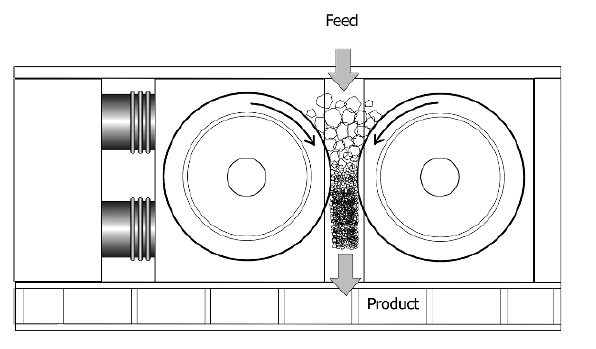
Fig3. Schematic diagram of a High Pressure Grinding Roll (HPGR).
To perform the operation, pressure is applied hydraulically through four cylinders to the
roll that is designed to move laterally. The second roll is immovable. A crushing pressure of the order of 200 MPa is applied. The dimensions of the rolls used in the mineral industry are 0.7- 2.8 m diameter with a Length/Diameter ratio between 0.2 - 0.6. The roll speeds are 85-105 m/min. The roll faces are either studded or have Ni-hard liners. The studs are made of tungsten carbide to combat heavy abrasion but softer studs have better life as they are less brittle.
Due to the fact that fine product sizes can be obtained, the HPGR has been used both for crushing and grinding. In a crushing circuit it can replace secondary or tertiary crushers like cone crushers. In grinding circuits it can replace tertiary crushing and installed before a ball mill.
HPGR circuit
As the product size from HPGR is fine, the present tendency is to replace the conventional secondary and tertiary crushers with a single HPGR unit. Thus liberation size is more economically achieved and the product acceptable for down stream operations such as flotation. In some flow sheets HPGR is placed before the roll crusher in order to induce cracks and fissures in the ore particles. In such cases ball mill grinding is facilitated. A typical flow sheet for coarse grinding is illustrated in Fig4. Experiences claims great
energy savings when HPGR is used in closed circuit as combined pre-grinder and finishing grinding mill.
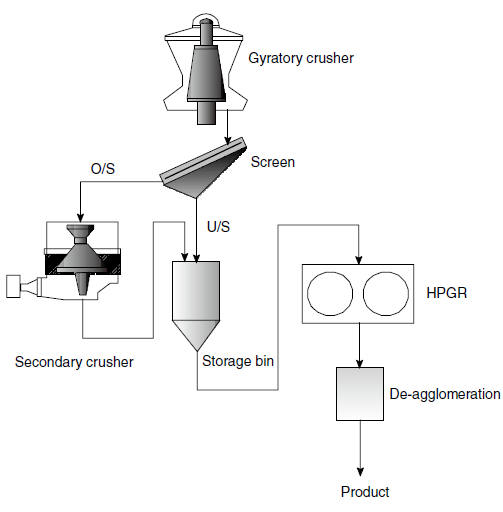
Fig4. HPGR circuit